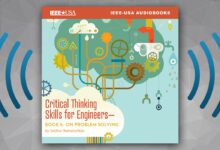
Thomas Alva Edison, considered by many to be the world’s greatest inventor, has been Harry T. Roman’s hero since childhood.
Inspired by Edison’s genius, Roman obtained an engineering degree, and he spent his 36-year career in research and development for the largest utility in New Jersey. Now a prolific educator and writer, he has just written the first of a planned three-volume e-book series for IEEE-USA E-Books: Thomas Edison: Man of the Millennium.
“My second career has enabled me to gain a broader perspective about Edison,” says Roman. “Working at the Thomas Edison National Historic Park in West Orange, and then with the Edison Innovation Foundation, have given me invaluable access to original Edison writings, artifacts and lab notebooks.”
He says the goal of his e-book series is much more than simply restating the inventor’s accomplishments. In Volume 1, “The Legacy,” Roman concentrates on the human element, including Edison’s habits and foibles.
For example, in the chapter, “Thinker, Inventor, Mechanic,” the author explains that Edison spent considerable time conceiving and planning his work—he was not simply a trial-and-error inventor. Edison thought seriously about what he did, and he usually conducted extensive research to gain a thorough understanding—of what others were doing.
“He could not have filled 4,000 notebooks, if all he did was scurry around in his lab trying different combinations of things,” writes Roman. He adds that Edison spent hours conceiving and researching ideas that he would later have his staff develop. His able craftsmen roughed out the prototypes and tested them; later, Edison often “tinkered” these devices to perfection, with his workers joining in.
Working on a number of projects at the same time was another of Edison’s habits—it wasn’t unusual for as many as 40 projects to be in various stages of progress on any given day.
The author postulates that organizing the R&D process may have been one of the inventor’s greatest achievements. “Edison believed that to be successful, there was an organized way to perform research,” he points out. “He created a means of perpetuating the industrial revolution, then sweeping late 19th century America.”
Roman then goes on to list the eight major considerations that Edison felt should be part of R&D, such as responding to a real market need, encouraging employees to use their own creative skills and methods, and having ample supplies of materials on hand.
In the chapter, “The Breakthrough Guy,” the author notes that nothing seemed to appeal more to Thomas Edison than being the one who did something new and unusual. “For him, the thrill was in the chase, the pursuit of the process to inventive victory—his mind against the problem, racing to be there first,” he writes. Here, Roman objectively examines one of Edison’s greatest shortcomings—losing sight of the true business advantage he might be creating, as soon as he had brought the original problem to heel.
“Some would say he squandered his lead in a number of technologies for the sake of taking up yet another grand chase in a different direction; only to return later to try and re-capitalize on his earlier lead—after other lesser, but well-financed, minds had entered the field,” he writes. “It certainly was the case with recorded sound. Edison could have done better in strategic business planning. He should have given more freedom and trust to others to market his inventions.”
Roman also observes that as the guiding coordinator of multiple projects at one time, Edison could suddenly shift interest without warning into new areas, or decide to launch improvements to existing work. “Sometimes,” he writes, “his staff was not sure which projects he might take a sudden interest in. If he locked into an area with intense interest, he might stay glued to that problem for weeks or months on end, disregarding previous business commitments, often ignoring his contractual demands for delivery of new inventions.” Further aggravating his reputation, Roman writes that Edison was notorious for not paying his creditors promptly—and it often affected the great inventor’s ability to get more materials quickly.
Such behavior had its consequences. The author notes that current investors became very nervous, and Edison’s unpredictability often frightened potential new investors away. Edison’s stay-in-the-lab approach also took a severe toll on his two wives and six children. The man had very little time for family life.
However, despite Thomas Edison’s personal and professional shortcomings, Roman advances a persuasive case for the inventor’s place—not only in the development of U.S. industry, but also in worldwide technical advances.
Two of the author’s statistical statements bear this out:
- In 1847, the year of Edison’s birth, the United States Patent Office recorded 5,000 patents. In 1935, four years after his death, two million patents were recorded.
- Economists believe that Edison’s accomplishments account for about 10 percent of the U.S. economy—about $1.6 trillion a year—and more than four times that, on a worldwide basis.
An IEEE Senior Member, Harry Roman holds 12 United States patents, and he has published more than 550 scientific papers, articles, monographs and books. Roman has received many honors and recognitions, from IEEE and other organizations, for his contributions to technology education. Most recently, IEEE honored him with the 2015 Region 1 Excellence in Teaching Award. Retired since 2006 from PSE&G, Roman has published more than 70 resource books, science kits, and other educational products. He currently teaches graduate students at Montclair State University how to apply STEM techniques in the classroom.
Volume 1 of Thomas Edison: Man of the Millennium is available to members for $2.99 and to non-members $4.99, at: https://ieeeusa.org/sdm_downloads/audiobook-thomas-edison-man-of-the-millennium-volume-1-the-legacy/.
Helen Horwitz is an award-winning freelance writer who lives in Albuquerque, N.M. She was with IEEE from 1991 through 2011, the first nine as Staff Director, IEEE Corporate Communications.






